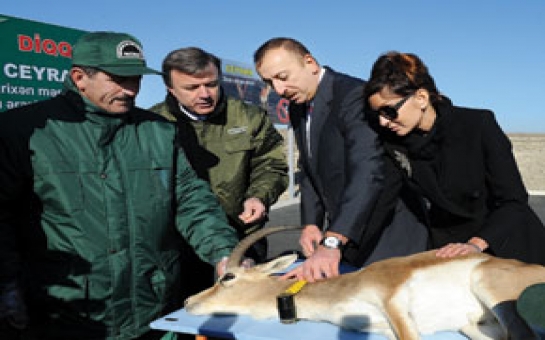Follow us !
Gazelles coming home - reintroduction in Azerbaijan and Georgia
Society
11:00 | 27.12.2013

Gazelles coming home - reintroduction in Azerbaijan and Georgia
Thousands of gazelles once grazed the plains of Azerbaijan, from Jeyranchol in the west to the Caspian coast in the east. Travellers wrote of steppes covered by gazelles as far as the eye could see. But in the first half of the 20th century numbers fell dramatically. In 1961 an official count of gazelles from the air found only 171. The drastic decline was the result of hunting and habitat loss as large areas of land were used for agriculture.Now Azerbaijan’s Shirvan National Park is home to at least 6,000 gazelles and an ambitious programme is under way to reintroduce the gazelle to its historic habitat in other parts of the country and the Caucasus. Anne Thompson looks at the life of the gazelle in Azerbaijan and the work done to conserve this graceful animal.Symbol of beautyGazelles have a special place in Azerbaijani culture as a symbol of natural beauty, grace and purity. Jeyran, the Azerbaijani word for gazelle, is a girl’s name and a term of endearment. Many a young Azerbaijani has likened his beloved to a gazelle, especially her eyes and eyebrows. Gazelles feature in medieval miniatures, poetry and song, while the moves of the traditional Jeyran dance mimic the elegance of the gazelle.Thousands of gazelles once grazed the plains of Azerbaijan, from Jeyranchol in the west to the Caspian coast in the east. Travellers wrote of steppes covered by gazelles as far as the eye could see. But in the first half of the 20th century numbers fell dramatically. In 1961 an official count of gazelles from the air found only 171. The drastic decline was the result of hunting and habitat loss as large areas of land were used for agriculture.Now Azerbaijan’s Shirvan National Park is home to at least 6,000 gazelles and an ambitious programme is under way to reintroduce the gazelle to its historic habitat in other parts of the country and the Caucasus. Anne Thompson looks at the life of the gazelle in Azerbaijan and the work done to conserve this graceful animal.Symbol of beautyGazelles have a special place in Azerbaijani culture as a symbol of natural beauty, grace and purity. Jeyran, the Azerbaijani word for gazelle, is a girl’s name and a term of endearment. Many a young Azerbaijani has likened his beloved to a gazelle, especially her eyes and eyebrows. Gazelles feature in medieval miniatures, poetry and song, while the moves of the traditional Jeyran dance mimic the elegance of the gazelle.The oldest fossils of gazelles found in the Caucasus date back two million years, according to zoologist and palaeontologist Damir Hajiyev. Gazelles were a source of food hunted by early man, and can be seen in the Stone Age petroglyphs at Qobustan, south-west of Baku.References to gazelles occur in place names – Jeyranchol or Gazelle Steppe lies in western Azerbaijan, bordering on Georgia. Jeyranbatan is the name of a large water reservoir outside Baku and translates as “drowning gazelle”. The village of Jeyrankechmez lies between Baku and Shamakhi and its name means “the gazelle cannot cross”. Goitered gazelleThe species of gazelle native to Azerbaijan is the goitered gazelle (Gazella subgutturosa subgutturosa). Goitered gazelles can be found across the Middle East, Central Asia and Mongolia, but one of the largest concentrations lives in Azerbaijan’s Shirvan National Park.During the rutting season, the bucks have swollen larynxes which resemble a goitre (a swelling on the neck caused by lack of iodine), hence the species’ name.Goitered gazelles are between 90 and 115 cm long in the body and stand 60-80 cm tall (measuring from the ground to the base of the neck), according to specialists from Azerbaijan’s Ministry of Ecology and Natural Resources. Adult males weigh up to 25 kg and females up to 20 kg. Unusually for gazelle species, only the bucks have horns, which are black and gently curved.Goitered gazelles are a fawn colour on the back and legs while their bellies are white, a colouring that allows them to blend in to their environment. They have black tails which, when raised, stand out against the white buttocks. If you see the gazelles running away across the Shirvan plain, you might mistake their bobbing white haunches for white birds hovering above the ground.The rutting season is in November-December with the mating season in November-February and births in May-June. Does usually give birth to one or two calves. The young lie camouflaged away from their mothers for the first two weeks, gaining strength and learning to stand on their wobbly legs. The mother generally returns to feed her calves two to three times a day.In summer, gazelles are to be found in small family groups of two to five animals, while in winter they form large herds with dozens or even hundreds of individuals.The average lifespan of a goitered gazelle in the wild is seven to nine years and 10-11 years in captivity. Habits and habitatGoitered gazelles live in semi-desert areas and arid foothills where they feed on grasses, leaves and shoots. They consume about 30% of their body weight in green matter per day, and can derive most of their needed moisture from it. Gazelles need to drink water every day only during the heat of summer. Gazelles in Azerbaijan’s Shirvan National Park drink salt water from the Caspian Sea and have even been known to enjoy a spot of sea-bathing, according to park director Seymur Karimov.Not surprisingly when they have such a high food intake, gazelles spend most of their time grazing, wandering the steppe as they do so. In summer, visitors to the Shirvan National Park can see the gazelles out and about in early morning and late afternoon. During the midday heat, they take shelter in the shade, excavating shallow oval pits to lie in. During the cooler winter months, the gazelles can be seen for most of the day.Gazelles have acute sight and hearing. At the slightest hint of danger, they stop grazing and raise their heads, staring intently in the direction of the possible threat. They prick up their ears and wag their tails vigorously as a sign to other gazelles. If the threat is imminent, gazelles paw the ground with their front hooves, raise their tails and run rapidly at speeds of up to 60 kmph. They also jump forward on all four legs – a move known as stotting – which may be to draw the attention of other gazelles or to warn off predators by showing their speed and agility.Herds cover 10 to 30 kilometres per day in the winter, but much less in summer. Gazelles like to graze among the saxaul bushes around Flamingo Lake in the north of the Shirvan National Park. They tend to congregate in the northern and western parts of the park in summer and migrate east and south to the Caspian Sea coast in autumn and winter. The saxaul bushes provide both food and shelter as they migrate.The main predators of the goitered gazelle include jackals, domestic dogs and wolves. Although there is a thriving wolf population in the Shirvan National Park, it does not seem to have a strong influence on the gazelle population, park director Seymur Kazimov says. Several observations show that wolves are not able to catch a healthy gazelle. Only injured, sick or old animals get caught. Dramatic declineIn the early 20th century some 50-60,000 gazelles grazed the Mil-Karabakh, Mugan and Shirvan plains of Azerbaijan (see the map), according to zoologist M.A. Safarov (1961). An official count of gazelles from the air in 1961 found only 171. Over the years the gazelle had been hunted and its habitat had shrunk because of the spread of agriculture.The Soviet authorities moved to protect the gazelles, setting up the Bandovan sanctuary in the south-east of the Shirvan plain in 1961. The larger Shirvan State Reserve was established in 1969, and enlarged in 1982. In 2003 the independent Azerbaijan Republic established the Shirvan National Park on the basis of the existing reserve with the main aim of conserving the gazelle.The 54,000-hectare park is now home to at least 6,000 gazelles – the largest single population of goitered gazelles anywhere in Europe. The Shirvan population accounts for 90 per cent of all gazelles in Azerbaijan and is crucial to the survival of the species in the country.A second isolated gazelle population lives in the Bozdag hills, south of Mingachevir reservoir, but these animals are not considered to be such healthy stock.There is a problem in the concentration of gazelles in Shirvan. Both the natural landscape and man-made obstacles combine to isolate the gazelles within the park. They used to be able to migrate to other suitable habitat north-west of the park, but this route has now been blocked by the upgraded Alat-Astara highway.An isolated population is vulnerable to catastrophic losses due to outbreaks of disease or random events… A sequence of droughts could also lead to sudden falls in numbers.This is the view of Dr David Mallon, co-chair of the IUCN/SSC Antelope Specialist Group. In 2008 Dr Mallon led a rapid assessment survey on the Rehabilitation of Historical Range of Goitered Gazelles in Azerbaijan. The report was produced with the support of the Worldwide Fund for Nature (WWF) Caucasus Programme and the Large Herbivore Foundation. The survey noted that reintroducing populations to former sites is essential for the long-term security of Azerbaijan’s gazelles and is desirable from the point of view of restoring the country’s biodiversity. The report was compiled as a part of a project initiated by the Ministry of Ecology and Natural Resources of Azerbaijan in collaboration with the Heydar Aliyev Foundation, IDEA (International Dialogue for Environmental Action) and WWF.ReintroductionThe reintroduction project was officially launched on 24 December 2010. President Ilham Aliyev and First Lady Mehriban Aliyeva watched as radio collars were attached to gazelles ahead of their release in the Qobustan area. Of course, a considerable amount of work had been done prior to this.The providers of expert technical support for the project, German development agency GIZ and the WWF organized special training for all the staff involved in the reintroduction programme. First, the gazelles had to be captured in Shirvan National Park. Two kilometres of nets were used to trap the gazelles, who were then driven into a stockade. The gazelles may be relatively light but, as everyone involved in trapping the gazelles found, they are very strong and their hooves are sharp.The WWF helped the Ministry of Ecology and Natural Resources obtain the special collars, which are fitted to the gazelles before their release into their new habitat. The collars transmit daily and weekly satellite signals giving details of location. This allows the ministry and specialists from the WWF to track the gazelles’ health and movements and to assess the best areas for the reintroduction of gazelles.Just two gazelles have been lost in the programme. One was eaten by a wolf near Perekushkul settlement in Absheron District and the other by a lynx in the Ajinohur steppe near the border with Georgia. The GPS signals from the collars alerted the ministry and WWF and the same day their specialists reached the gazelles. All that remained were the carcasses and collars, which were reclaimed.To date, more than 110 gazelles have been re-introduced in three areas: Qobustan-Absheron, south-west of Baku; the Ajinohur steppe, north of Mingachevir; and Ag Gol National Park in south-west Azerbaijan. In all three areas the gazelles have settled and bred, the ministry is pleased to report.AwarenessPublic information is an important component of the reintroduction project. With the help of Germany’s KfW and the Transboundary Joint Secretariat, an organization that encourages environmental cooperation in the South Caucasus, the Ecology Ministry has produced special booklets to explain the programme to local people. It is especially important for shepherds to be aware of the project, as sheep dogs pose one of the greatest threats to the gazelles. Road signs have also been erected to warn drivers to watch out for gazelles.The Ecology Ministry is proud to report that there have been no cases of poaching in the past four years. They put this down to the near sacred status enjoyed by the gazelle amongst the Azerbaijani people and to the raising of awareness that poaching gazelles is a criminal offence. Gazelles for GeorgiaOne of the areas selected for reintroduction, the Ajinohur steppe, borders on Georgia, where the goitered gazelle became extinct in the 20th century. This stretch of the border is formed by the River Alazan, which the gazelles are able to cross. Georgia too has been working to reintroduce the gazelle. Ten gazelles from Turkey were settled in the Vashlovani National Park on the Georgian side of the border as part of a special Georgian-Turkish-US project. Three calves have since been born. The next arrivals due at Vashlovani are gazelles from Shirvan. The animals pictured opposite are being kept in the stockade at the Shirvan National Park until they can be transported to their new home.Gazelle gazingThe best place to see the goitered gazelle is the Shirvan National Park, which covers some of the last untouched semi-desert steppe in Azerbaijan. Don’t be put off by the arid landscape – the park is teeming with life. The gazelles can be seen at any time of year, but very wisely they tend to be less active in the middle of the day during the hot summer months and in wet weather.The park lies some 100 km south of Baku on the highway to Astara, between Alat and Salyan. It’s easy to find as the entrance is marked with a gazelle statue. The park is open every day between 9.00 am and 6.00 pm. Visits, however, need to be planned in advance as the modest entrance fee of AZN 2 for local people and AZN 4 for foreigners has to be paid online or at any branch of Kapital Bank. The payment procedures can be found on the Shirvan National Park website http://shirvan-national-park.az If you pay online, be sure to print out your proof of payment and take it with you to the park. Despite the complications in making payments, the park management and Ministry of Ecology and Natural Resources are keen to encourage visitors. The park has one shorter and two longer routes for vehicles. An ordinary car is fine for the main routes, but not only does a four-wheel drive cope better with the mud, it gives a better view of the gazelles and other wildlife. The park is also home to wolves, marsh frogs, tortoises, jerboa, snakes and other animals.Shirvan has a rich birdlife, which becomes even more varied during the spring and autumn migrations. Larks, colourful bee-eaters, hoopoes and little bustards are amongst the park’s residents. Water birds can be seen from the observation platform at Flamingo Lake, in particular egrets, herons, pelicans, cormorants, purple swamp hens, many varieties of duck and goose and, of course, the eponymous flamingo. (Visions.az)ANN.Az










